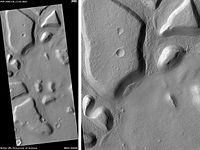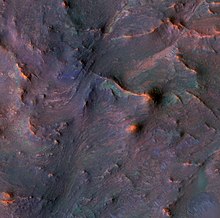尼羅瑟提斯桌山群
| 尼羅瑟提斯桌山群 | |
|---|---|
 阿斯塔普斯小丘群中的山岡和凸岩 | |
| 坐標 | 36°52′N 67°54′E / 36.87°N 67.9°E座標:36°52′N 67°54′E / 36.87°N 67.9°E |


尼羅瑟提斯桌山群(Nilosyrtis Mensae)位於火星卡西烏斯區,其中心坐標為北緯36.87°、東經67.9°,它的東西經度分別為74.4°E和 51.1°E;南北緯度分別是 29.61°N和 36.87°N[2][2]。尼羅瑟提斯桌山群正對着西面的普羅敦尼勒斯桌山群,二者都坐落在火星分界線上。該桌山群縱橫約705公里(438英里),取名自火星古典反照率特徵,1973年被國際天文聯合會正式接受。
尼羅瑟提斯桌山群的表面被歸屬為銳蝕地形(Fretted Terrain)。這裡有懸崖、台地和寬闊平坦的山谷,其表面地貌被認為是由岩屑覆蓋的冰川所造成[3][4]。這些圍繞着丘群和桌山的冰川,被稱為舌狀岩屑坡[5][6][7][8];當冰川位於山谷中時,又被稱為線狀谷底沉積[9][10][11][12]。
氣候變化導致的富冰特徵[編輯]
幾十年來,火星上的許多地貌特徵,包括尼羅瑟提斯桌山群,都被認為含有大量的冰。這一想法被火星勘測軌道飛行器上的淺層雷達(SHARAD)所證實,勘測結果表明,舌狀岩屑坡(LDA)和線狀山谷沉積(LVF)都含有純淨水冰,上面覆蓋着一層隔溫的薄岩層 [13][14]。在北半球包括尼羅瑟提斯桌山群在內的許多地方都發現了冰[15]。
關於冰的起源,最流行的模型是火星自轉軸傾角的巨幅變化所引起的氣候改變,有時傾斜角甚至超過80度[16][17],巨大的傾斜變化解釋了為何火星上有許多富含冰的特徵。
研究表明,當火星的傾角從目前的25度傾斜到45度時,兩極的冰就不再穩定[18],此外,在這一高傾角時,固體的二氧化碳(乾冰)就會升華,從而增加了大氣壓力,這種增加的壓力會使更多的塵埃保留在大氣中,大氣中的水分將以雪或冰的形式落在塵埃顆粒上,計算表明這種物質將集中在中緯度地區[19][20],火星大氣環流模式預測,富冰塵埃將會堆積在已發現有富冰特徵的同一區域[21]。 當火星傾斜角逐慚回歸到較低值時,水冰將會升華(直接變成氣體)[22][22][23]並留下一層塵埃,留下的沉積覆蓋了底層物質。所以每次自轉軸的大幅度搖擺循環,都會使一些富冰層留在下面[24]。注意,光滑的表面覆蓋層可能只代表相對較新的物質。
另請參閱[編輯]
參考資料[編輯]
- ^ The Color Palette of Nilosyrtis Mensae (頁面存檔備份,存於網際網路檔案館) at University of Arizona/HiRISE
- ^ "尼羅瑟提斯桌山群". Gazetteer of Planetary Nomenclature. USGS Astrogeology Research Program.
- ^ Greeley, R. and J. Guest. 1987. Geological map of the eastern equatorial region of Mars, scale 1:15,000,000. U. S. Geol. Ser. Misc. Invest. Map I-802-B, Reston, Virginia
- ^ Sharp, R. 1973. Mars Fretted and chaotic terrains. J. Geophys. Res.: 78. 4073-4083
- ^ Plaut, J. et al. 2008. Radar Evidence for Ice in Lobate Debris Aprons in the Mid-Northern Latitudes of Mars. Lunar and Planetary Science XXXIX. 2290.pdf
- ^ Carr, M. 2006. The Surface of Mars. Cambridge University Press. ISBN 978-0-521-87201-0
- ^ Squyres, S. 1978. Martian fretted terrain: Flow of erosional debrid. Icarus: 34. 600-613.
- ^ ISBN 0-8165-1257-4
- ^ Morgan, G. and J. Head III. 2009. Sinton crater, Mars: Evidence for impact into a plateau icefield and melting to produce valley networks at the Hesperian-Amazonian boundary. Icarus: 202. 39–59.
- ^ Morgan, G. et al. 2009. Lineated valley fill (LVF) and lobate debris aprons (LDA) in the Deuteronilus Mensae northern dichotomy boundary region, Mars: Constraints on the extent, age, and episodicity of Amazonian glacial events. Icarus: 202. 22–38.
- ^ Head, J., et al. 2006. Extensive valley glacier deposits in the northern mid-latitudes of Mars: Evidence for the late Amazonian obliquity-driven climate change. Earth Planet. Sci. Lett. 241. 663-671
- ^ Head, J., et al. 2006. Modification if the dichotomy boundary on Mars by Amazonian mid-latitude regional glaciation. Geophys. Res Lett. 33
- ^ Plaut, J. et al. 2008. Radar Evidence for Ice in Lobate Debris Aprons in the Mid-Northern Latitudes of Mars. Lunar and Planetary Science XXXIX. 2290.pdf
- ^ 存档副本. [2020-11-02]. (原始內容存檔於2021-03-09).
- ^ Plaut, J., A. Safaeinili,, J. Holt, R. Phillips, J. Head, J., R. Seu, N. Putzig, A. Frigeri. 2009. Radar evidence for ice in lobate debris aprons in the midnorthern latitudes of Mars. Geophys. Res. Lett. 36. doi:10.1029/2008GL036379.
- ^ Touma J. and J. Wisdom. 1993. The Chaotic Obliquity of Mars. Science 259, 1294-1297.
- ^ Laskar, J., A. Correia, M. Gastineau, F. Joutel, B. Levrard, and P. Robutel. 2004. Long term evolution and chaotic diffusion of the insolation quantities of Mars. Icarus 170, 343-364.
- ^ Levy, J., J. Head, D. Marchant, D. Kowalewski. 2008. Identification of sublimation-type thermal contraction crack polygons at the proposed NASA Phoenix landing site: Implications for substrate properties and climate-driven morphological evolution. Geophys. Res. Lett. 35. doi:10.1029/2007GL032813.
- ^ Levy, J., J. Head, D. Marchant. 2009a. Thermal contraction crack polygons on Mars: Classification, distribution, and climate implications from HiRISE observations. J. Geophys. Res. 114. doi:10.1029/2008JE003273.
- ^ Hauber, E., D. Reiss, M. Ulrich, F. Preusker, F. Trauthan, M. Zanetti, H. Hiesinger, R. Jaumann, L. Johansson, A. Johnsson, S. Van Gaselt, M. Olvmo. 2011. Landscape evolution in Martian mid-latitude regions: insights from analogous periglacial landforms in Svalbard. In: Balme, M., A. Bargery, C. Gallagher, S. Guta (eds). Martian Geomorphology. Geological Society, London. Special Publications: 356. 111-131
- ^ Laskar, J., A. Correia, M. Gastineau, F. Joutel, B. Levrard, and P. Robutel. 2004. Long term evolution and chaotic diffusion of the insolation quantities of Mars. Icarus 170, 343-364.
- ^ 22.0 22.1 Mellon, M., B. Jakosky. 1995. The distribution and behavior of Martian ground ice during past and present epochs. J. Geophys. Res. 100, 11781–11799.
- ^ Schorghofer, N., 2007. Dynamics of ice ages on Mars. Nature 449, 192–194.
- ^ Madeleine, J., F. Forget, J. Head, B. Levrard, F. Montmessin. 2007. Exploring the northern mid-latitude glaciation with a general circulation model. In: Seventh International Conference on Mars. Abstract 3096.
| ||||||||||||||||||||||||||||||||||||||||||||||||||||||||||||||||||||||||||||||||||||||||
